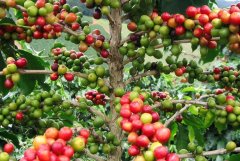Coffee tasting related: is there really a "taste map"?
Truth: the idea of "taste map" has been around for decades. In fact, the cells that distinguish all kinds of taste exist in every taste bud, and the taste buds are distributed on the surface of the tongue and in the mouth, that is to say, the area with taste buds on the tongue can sensitively distinguish all taste senses. The rumored "taste map" actually does not exist. This textbook-level rumor actually comes from the scholars' false translation of the article.
In 1901, a German scientist published an article on the study of taste, describing the phenomenon that some people's tongues are more sensitive to a particular sense of taste, which is not a clear scientific conclusion. However, it makes people think that several areas on the tongue are only responsible for a specific sense of taste. Later, this fallacy was translated into English by Edwin G. Boring, a psychiatrist at Harvard University, and spread widely. After that, people have a gradually in-depth study of taste, and found that this is not the case. Let's review the conclusions of these studies before depicting the real "taste map".
The "three primary colors" of taste
In animals, the function of taste is to judge the nutritional value of food and avoid eating poisons. In human beings, taste has an additional meaning, that is, the pleasure of enjoying delicious food. After long-term research, people have found that mammalian tastes can recognize five basic tastes: sweet, fresh, bitter, sour and salty. Recently, there is also some evidence that animals recognize "fat". However, there is no consensus in academic circles on whether this fatty taste forms the sixth basic taste. Sweetness usually means that food is rich in energy, delicious taste represents food rich in protein (the taste of amino acids formed after protein decomposition), and salty taste enables people to eat the right amount of electric hydrolysate to maintain the balance of water and salt in the body. sour and bitter taste suggest toxic or potentially harmful chemicals.
A special structure on the tongue
Stick out your tongue in front of the mirror (it is recommended that when no one is there, dear), you will find that the surface of the tongue is rough, covered with many small protuberances, which are collectively called tongue nipples. The lingual nipple is divided into many kinds, the red round protuberances around the 1mm are called fungal nipples, which look like mushrooms under the microscope, hence the name; the lingual nipples near the tongue boundary groove at the end of the tongue are much larger than the fungiform nipples, and there is a ring around each protuberance (people who can't stick out the tongue can't see it themselves), they are called contour nipples. The fungal nipple and the contoured nipple are filled with conical filamentous nipples. There are many leafy nipples on the tongues of herbivores, and the phylloid nipples on the human tongue are almost degraded.
Taste is produced by taste receptor cells (taste-receptor cell, TRC). The taste receptor cells are concentrated in the taste buds, while the taste buds are mainly distributed in the nipples of the tongue, palate and throat mucosa. The top of the taste bud is the taste pore, which opens on the surface of the tongue. There are one to hundreds of taste buds in each nipple, and there are 50 to 150 taste receptor cells in each taste bud. The taste receptor cells recognize different taste stimuli and encode neuroelectrical signals. The taste information carried by these signals is transmitted to the cerebral cortex through special sensory nerves, and eventually becomes taste sensation.

Important Notice :
前街咖啡 FrontStreet Coffee has moved to new addredd:
FrontStreet Coffee Address: 315,Donghua East Road,GuangZhou
Tel:020 38364473
- Prev

How does the Philharmonic pressure come from? who invented the Philharmonic pressure?
AeroPress was officially released by American AEROBIE Company in 2005. It was listed and aroused strong repercussions because of its advantages such as easy to use, high efficiency and delicious coffee. The new coffee-making apparatus was invented by Alan Adler, a mechanical engineering lecturer at Stanford University, who holds more than 40 patents in the United States and other countries. Aiole pressure is a kind of manual cooking.
- Next

Do you know the 13 uses of coffee? The benefits of coffee
1. A clinical trial in Illinois has found that caffeine, which slows the blood flow of blood vessels in the body, can also reduce the intensity and frequency of headaches. One group was only allowed to drink coffee, while 58% reported being completely relaxed. While the other group drank coffee and ibuprofen at the same time, 70% of the headache disappeared. But drinking coffee for migraine
Related
- Beginners will see the "Coffee pull flower" guide!
- What is the difference between ice blog purified milk and ordinary milk coffee?
- Why is the Philippines the largest producer of crops in Liberia?
- For coffee extraction, should the fine powder be retained?
- How does extracted espresso fill pressed powder? How much strength does it take to press the powder?
- How to make jasmine cold extract coffee? Is the jasmine + latte good?
- Will this little toy really make the coffee taste better? How does Lily Drip affect coffee extraction?
- Will the action of slapping the filter cup also affect coffee extraction?
- What's the difference between powder-to-water ratio and powder-to-liquid ratio?
- What is the Ethiopian local species? What does it have to do with Heirloom native species?

